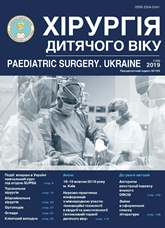Influence of different types of portocaval shunting operations on the immune status in children with extrahepatic portal hypertension
DOI:
https://doi.org/10.15574/PS.2019.63.41Keywords:
portal hypertension, immune status, mesocaval shunt, splenorenal shunt, childrenAbstract
Objective. The paper is focused on the features and grade of changes in the immune system under the extrahepatic portal hypertension and after splenorenal and mesocaval shunting operations.
Materials and methods. In the study were included 100 children, in whom the cell, humoral and unspecific parts of immune system were evaluated. The leading pathological factors were defined.
Results. It was established that there is significant tensity in the humoral part (IgМ, IgA) and phagocytosis, secondary cell immune deficiency with decreasing of general number of lymphocytes and subpopulations of lymphocytes (СD3+, СD4+, СD8+). Immunological parameters after splenorenal shunting were statisticily significant approached to the age norms (p<0,05) comparing to those after mesocaval shunting. However, the operative treatment essentially doesn’t improve the condition of the immune system.
Conclusion. The parameters of immunogramme should be considered while monitoring such category of patients, selection of the immunocorrective and detoxication therapy for prevention of postoperative complications and for the further management under extrahepatic portal hypertension.
References
Dzhuma K, Prytula V, Godik O, Ishchenko II. (2012) Immune status of children children with extrahepatic portal hypertension. Ukrainian scientific medical youth journal. 1: 52–59.
Kalita NA, Bulanov KI, Kotenko OG. (1991). Correction of secondary hypersplenism in surgery of portal hypertension. Herald of Surgery. 3: 137–139.
Kryvcheniya DU, Dubrovin AG, Prytula VP, Grishin AA. et al. (2008). Diagnosis of portal hypertension in childhood. Clinical Surgery. 3: 17–19.
Khanna R, Sarin SK. (2014). Non-cirrhotic portal hypertension – diagnosis and management. J Hepatol. 60: 421–41. https://doi.org/10.1016/j.jhep.2013.08.013; PMid:23978714
Khanna R, Sarin SK. (2018). Idiopathic portal hypertension and extrahepatic portal venous obstruction. Hepatol Int. 12: 148–67. https://doi.org/10.1007/s12072-018-9844-3; PMid:29464506
Poddar U, Thapa B, Rao K, Singh K. (2014). Etiological spectrum of esophageal varices due to portal hypertension in Indian children: is it different from the West? Clin Liver Dis. 18: 451–476.
Sen Sarma M1, Yachha SK, Rai P, Neyaz Z, Srivastava A, Poddar U. (2018). Cholangiopathy in children with extrahepatic portal venous obstruction. J Hepatobiliary Pancreat Sci.25: 440–447. https://doi.org/10.1002/jhbp.582; PMid:30259697
Triana Junco P, Alvarez A, Dore M, Jimenez Gomez J et al. (2019). Long-term results after diversion surgery in extrahepatic portal vein obstruction. Eur J Pediatr Surg.29: 23–27. https://doi.org/10.1055/s-0038-1668147; PMid:30086576
Young V, Rajeswaran S. (2018). Management of portal hypertension in the pediatric population: a primer for the interventional radiologist. Semin Intervent Radiol.35: 160–164. https://doi.org/10.1055/s-0038-1660794; PMid:30087518
Downloads
Issue
Section
License
The policy of the Journal “PAEDIATRIC SURGERY. UKRAINE” is compatible with the vast majority of funders' of open access and self-archiving policies. The journal provides immediate open access route being convinced that everyone – not only scientists - can benefit from research results, and publishes articles exclusively under open access distribution, with a Creative Commons Attribution-Noncommercial 4.0 international license(СС BY-NC).
Authors transfer the copyright to the Journal “PAEDIATRIC SURGERY.UKRAINE” when the manuscript is accepted for publication. Authors declare that this manuscript has not been published nor is under simultaneous consideration for publication elsewhere. After publication, the articles become freely available on-line to the public.
Readers have the right to use, distribute, and reproduce articles in any medium, provided the articles and the journal are properly cited.
The use of published materials for commercial purposes is strongly prohibited.

